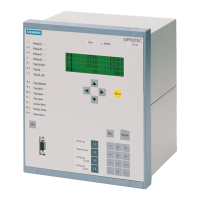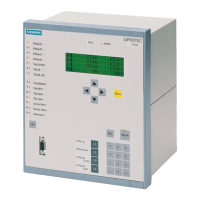Mounting and Commissioning
3.3 Commissioning
SIPROTEC, 7UM62, Manual
C53000-G1176-C149-7, Release date 03.2010
422
Symmetrical Current Test
The operational measured values supplied by the 7UM62 device allow a fast commissioning without external
instruments. The indices of the measured currents are as follows:
The symbol for current I is followed by the phase identifier Lx and by the index of the side of the protected object
(e.g. the transformer winding). Example:
IL1S1 Current in phase L1 on side 1.
Absolute Value Measurement
Compare the current magnitudes under Measurement → Secondary Values → Operational values second-
ary with the actually flowing values:
IL1S1 =
IL2S1 =
IL3S1 =
IL1S2 =
IL2S2 =
IL3S2 =
If deviations occur that cannot be explained by measuring tolerances, either a connection or the test setup is
wrong:
• Disconnect the protected object (shut down generator), and earth it,
• Re-check the plant connections to the device and the test arrangement and correct them.
• Repeat measurement and recheck measured values.
Angle Measurement
If the current magnitudes are consistent, the next step is to check the phase angle relations between the cur-
rents (ϕIL1S1, ϕIL2S1, ϕIL3S1, ϕIL1S2, ϕIL2S2, ϕIL3S2). The angle differences are in each case referred to
winding L1 of side 1.
Check the phase angle under Measurement → Secondary Values → Phase angles of side 1 of the protected
object. All angles are referred to IL1S1.
Consequently, a clockwise phase rotation should produce roughly the following results:
ϕL1S1 = 0°
ϕL2S1 = 240°
ϕL3S1 = 120°
If the angles are not correct, wrong polarity or connection phase interchange at side 1 is the cause.
• Disconnect the protected object (shut down generator), and earth it,
• Re-check the plant connections to the device and the test arrangement and correct them.
• Repeat measurement and recheck measured values.
Check the phase angle under Measurement
→ Secondary Values → Phase angles of side 2 of the device.
All angles are referred to IL1S1. If the angles are not correct, wrong polarity or line phase interchange at side
2 is the cause; proceed as for side 1.
The angles of the through-flowing currents between the different sides of the protection object are defined such
that a current of equal phase flowing through the protected object, provided that the connections are correct,
produces the angle difference at the two measuring points of 180° between currents of the same phase. Ex-
ception:Transverse differential protection where both currents must be in phase!

